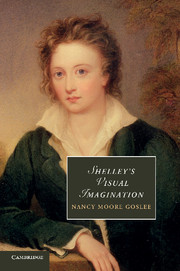Book contents
- Frontmatter
- Contents
- List of illustrations
- Acknowledgments
- 1 Introduction: text and figure
- 2 Mab's metamorphoses
- 3 “Hymn to Intellectual Beauty”: visual texts, invisible figure
- 4 “Clear elemental shapes”: communicating Greek liberty in Laon and Cythna
- 5 Anarchy's textual progress: representing liberty
- 6 Refiguring genre in Shelley's “Ode to Liberty”
- 7 Dispersoning Emily: drafting as plot in Epipsychidion
- 8 “Compelling / All new successions”: death and the poet's figurations in Adonais
- 9 The Triumph of Life: figure, history, and inscription
- Notes
- Bibliography
- Index
- CAMBRIDGE STUDIES IN ROMANTICISM
3 - “Hymn to Intellectual Beauty”: visual texts, invisible figure
Published online by Cambridge University Press: 05 March 2014
- Frontmatter
- Contents
- List of illustrations
- Acknowledgments
- 1 Introduction: text and figure
- 2 Mab's metamorphoses
- 3 “Hymn to Intellectual Beauty”: visual texts, invisible figure
- 4 “Clear elemental shapes”: communicating Greek liberty in Laon and Cythna
- 5 Anarchy's textual progress: representing liberty
- 6 Refiguring genre in Shelley's “Ode to Liberty”
- 7 Dispersoning Emily: drafting as plot in Epipsychidion
- 8 “Compelling / All new successions”: death and the poet's figurations in Adonais
- 9 The Triumph of Life: figure, history, and inscription
- Notes
- Bibliography
- Index
- CAMBRIDGE STUDIES IN ROMANTICISM
Summary
Given the elusive subject – or, better, the object – of the speaker's prayer in Shelley's “Hymn to Intellectual Beauty,” it is entirely appropriate that the first appearance of the poem in print was delayed several months because Leigh Hunt had lost the manuscript. During late 1816, several notices in The Examiner announced the imminent publication of a poem by a writer signing himself the “Elfin Knight.” After Shelley pulled together another copy from his draft notebooks, the poem finally appeared on January 19, 1817. “The following Ode,” the editor notes, “originally announced under the signature of the Elfin Knight, we have since found to be from the pen of the Author … mentioned, among others a week or two back in an article entitled ‘Young Poets.’” At the end of the poem appears the name of that young poet, “Percy B. Shelley.” Right below his name, filling the rest of the right column and continuing on the next page, is an article titled “Reform,” reporting “A select meeting of Independent Gentlemen, friends of economy, public order, and reform,” who had met to discuss “a constitutional Reform in the Commons House of Parliament,” a practical attempt to “free / This world from its dark slavery” (“Hymn,” ll. 71–2).
- Type
- Chapter
- Information
- Shelley's Visual Imagination , pp. 49 - 67Publisher: Cambridge University PressPrint publication year: 2011

